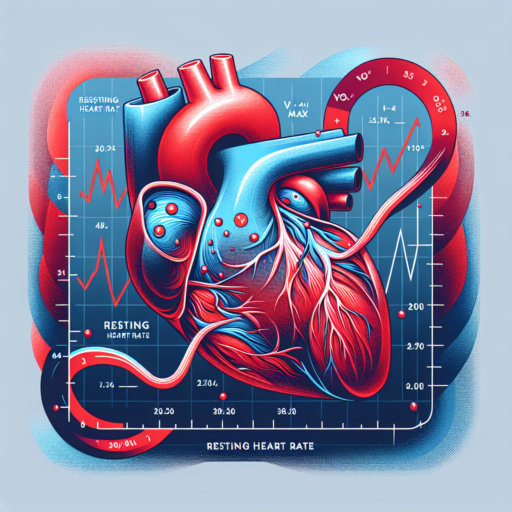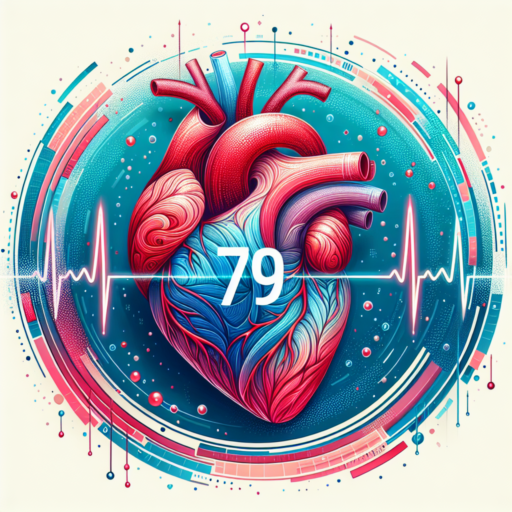Understanding VO2 Max and Its Connection to Resting Heart Rate
VO2 max, or maximal oxygen uptake, is an essential metric for athletes and fitness enthusiasts alike, denoting the maximum amount of oxygen your body can utilize during intense exercise. This measurement is crucial for understanding one’s cardiovascular and respiratory health, playing a significant role in endurance sports and high-intensity training regimes. However, the relationship between VO2 max and another critical health metric, the resting heart rate, often goes overlooked. This connection can unravel insights into not only your fitness levels but also the efficiency of your heart and lungs.
At its core, VO2 max is influenced by various factors, including age, genetics, sex, and, importantly, the condition of your cardiovascular system. It’s here that the resting heart response enters the picture. Generally, athletes and individuals with higher aerobic fitness exhibit a lower resting heart rate, indicative of a more efficient heart function. This efficiency, in turn, can suggest a higher VO2 max, illustrating the body’s proficient use of oxygen during maximal effort. The inverse relation between VO2 max and resting heart rate underlines a fundamental aspect of physical fitness: the stronger and more efficient your heart, the better it can pump oxygen-rich blood during intense workouts.
Understanding this link is pivotal for anyone looking to enhance their aerobic capacity and overall heart health. Through targeted training designed to improve VO2 max, individuals may observe a notable decrease in resting heart rate over time. Such improvements are a testament to the heart’s growing efficiency and the body’s enhanced capability to consume and utilize oxygen at peak levels. This synergy between resting heart rate and VO2 max serves as an invaluable benchmark for gauging aerobic fitness and endurance capabilities, enabling more strategic and focused training approaches.
Monitoring changes in both VO2 max and resting heart rate can also provide critical feedback for adjusting training intensity and volume, ensuring that workouts are optimally tailored to improving cardiovascular health and aerobic performance. By acknowledging and leveraging the connection between these two metrics, fitness enthusiasts and athletes can unlock new potentials in their exercise routines and achieve greater health and fitness milestones.
How to Calculate Your VO2 Max from Resting Heart Rate
Understanding your VO2 Max is crucial for gauging your cardiovascular fitness and overall endurance. Interestingly, your resting heart rate can serve as a gateway to estimating this vital metric. This method revolves around the principle that a lower resting heart rate usually indicates a higher VO2 Max, signifying better cardiovascular efficiency. Let’s delve into how you can leverage your resting heart rate to make an educated guess about your VO2 Max.
A simple way to estimate your VO2 Max is by using the Heart Rate Ratio Method. This approach entails recording your resting heart rate over a minute upon waking up for five consecutive days, calculating the average, and then applying it in a specific formula designed to estimate VO2 Max. The consistency in measurement ensures the accuracy of your resting heart rate average, providing a solid base for the calculation.
After obtaining your average resting heart rate, you can use it in conjunction with pre-determined equations or calculators available online, which factor in age, gender, and fitness level to approximate your VO2 Max. These calculators typically offer a quick and user-friendly means to translate your resting heart rate into a VO2 Max value, without the need for exhaustive physical testing.
The Science Behind Resting Heart Rate and VO2 Max Explained
Understanding the intricate connections between resting heart rate (RHR) and VO2 Max offers crucial insights into cardiovascular health and athletic performance. Resting heart rate, often measured immediately upon waking or after lying down for a considerable period, signifies the heart’s efficiency when the body is at rest. A lower RHR typically indicates a well-conditioned heart, which doesn’t have to work as hard to maintain a steady pace of pumping blood throughout the body.
On the other hand, VO2 Max represents the maximum amount of oxygen your body can utilize during intense exercise. It’s a pivotal measure, illustrating an individual’s aerobic endurance potential. Both elite athletes and recreational exercisers can benefit from understanding their VO2 Max as it directly correlates with their cardiovascular fitness levels. Not surprisingly, there is a connection between RHR and VO2 Max. A lower resting heart rate often suggests a higher VO2 Max, showcasing a heart that can pump more efficiently and maintain higher levels of physical exertion.
The science delves further into how training regimes impact both RHR and VO2 Max. Endurance training, for instance, can lead to significant improvements in VO2 Max by enabling the heart to pump a larger volume of blood with each beat. Consequently, this improvement in the heart’s pumping efficiency can also reflect in a lower RHR. This reinforcing cycle is a cornerstone of cardiovascular health, showcasing the direct impact that sustained, targeted exercise can have on enhancing heart function and overall physical fitness.
Improving Your VO2 Max: Tips and Strategies for Every Fitness Level
VO2 max, or maximal oxygen uptake, is a crucial measure of cardiovascular fitness and endurance capacity. Whether you’re a seasoned athlete looking to push your limits or a beginner aiming to enhance your aerobic fitness, understanding and improving your VO2 max can lead to significant improvements in your overall physical performance. Here, we focus on actionable tips and strategies tailored to various fitness levels for boosting your VO2 max.
Integrate Interval Training into Your Routine
Interval training is an effective method for enhancing VO2 max across all fitness levels. This involves alternating periods of high-intensity exercise with periods of rest or lower intensity exercise. For beginners, start with short bursts of intense activity, such as 30 seconds, followed by one to two minutes of recovery. Advanced athletes can increase the duration and intensity of the high-intensity intervals. Incorporating interval sessions into your weekly training schedule can lead to noticeable improvements in your aerobic capacity.
Incorporate Strength Training Exercises
Strength training, particularly exercises that target the major muscle groups, can complement your efforts to boost VO2 max. By improving muscle endurance and efficiency, you’re enabling your body to perform better during aerobic activities. Exercises such as squats, deadlifts, and lunges can be particularly beneficial. Aim to include strength training in your routine at least twice a week, ensuring you allow for adequate recovery between sessions.
Improving your VO2 max requires a mix of consistent aerobic exercise, strength training, and targeted interval training. By following the strategies outlined above, individuals at any fitness level can achieve improvements in their aerobic capacity. Remember, it’s crucial to listen to your body and adjust the intensity and duration of your workouts to match your current fitness level to avoid overtraining and injury. Progress may be gradual, but with persistence, you will notice improvements in your VO2 max and overall physical performance.
What Your Resting Heart Rate Can Tell You About Your Fitness
Understanding your resting heart rate (RHR) is a simple yet powerful way to gauge your overall fitness levels and cardiovascular health. The RHR refers to the number of heartbeats per minute while you are at a calm and restful state. Typically, a lower resting heart rate indicates a higher cardiovascular efficiency and a fitter body, as the heart needs to work less hard to pump blood throughout the body.
Fitness enthusiasts and athletes often boast a lower RHR as a result of rigorous training routines that enhance heart function and efficiency. However, it’s crucial for everyone, not just athletes, to be aware of their resting heart rate. Several factors can influence it, including stress levels, hydration, sleep quality, and even the time of day when the measurement is taken.
Interpreting Your Resting Heart Rate
To accurately measure your resting heart rate, it is recommended to take the reading first thing in the morning before you get out of bed. A normal RHR ranges from 60 to 100 beats per minute, but athletes or highly fit individuals might see numbers as low as 40 BPM. Consistently high readings, on the other hand, could signal an underlying health issue or a need for a lifestyle change to improve cardiovascular health and fitness.
The Importance of VO2 Max in Measuring Cardiovascular Fitness
Understanding the pivotal role played by VO2 Max in evaluating cardiovascular fitness can transform how athletes, coaches, and recreational exercisers approach training and wellness. This vital metric, which stands for the maximum volume of oxygen that an individual can use during intense exercise, serves as a mirror reflecting the aerobic physical fitness of a person. Essentially, a higher VO2 Max indicates a more significant ability of the heart, lungs, and muscles to consume oxygen, thereby spotlighting superior cardiovascular capacity.
One of the core benefits of focusing on VO2 Max is its strong correlation with endurance performance. Athletes across disciplines—ranging from marathon runners to cyclists—emphasize improving their VO2 Max levels to enhance their competitive edge. This is because oxygen plays a crucial role in energy production during prolonged physical activities. By optimizing the amount of oxygen the body can utilize, athletes can substantially boost their endurance and overall performance.
In addition to its importance in the realm of professional sports and athletics, VO2 Max also serves as an indispensable tool in the prevention and management of chronic diseases. Research has demonstrated a compelling link between higher VO2 Max scores and a reduced risk of heart disease, obesity, diabetes, and even certain types of cancer. Consequently, tracking and striving to improve VO2 Max can be a key component in maintaining holistic health and mitigating the risk of these conditions.
No se han encontrado productos.
Tools and Apps to Measure Your VO2 Max and Resting Heart Rate at Home
Understanding and tracking your VO2 Max and resting heart rate can be pivotal in assessing your cardiovascular fitness and overall health. Thanks to technological advancements, you no longer need to visit a professional lab to get these measurements. Various tools and apps available can provide you with accurate readings from the comfort of your home. In the following sections, we’ll explore some of the best options that have made monitoring these vital health metrics both accessible and straightforward.
Popular Apps for Measuring VO2 Max
Several smartphone apps have revolutionized the way we track our fitness metrics, including VO2 Max. MyFitnessPal, Strava, and Garmin Connect are standout apps that offer this functionality. These apps estimate your VO2 Max based on the workout data you input along with your heart rate during these activities. Although they might not be as accurate as clinical tests, they provide a useful estimation for those looking to improve their cardiovascular fitness.
Wearable Devices for Resting Heart Rate and VO2 Max
Wearable technology has seen significant advancements, with many devices now capable of measuring not just your resting heart rate but also your VO2 Max. Leading the pack are Fitbit, Garmin, and Apple Watch. These devices use sensors to monitor your heart rate throughout the day and estimate your VO2 Max during physical activity. It’s fascinating how these wearables can provide insights into your health and fitness levels, offering personalized data to help you achieve your fitness goals.
Real-Life Success Stories: How Increasing VO2 Max Transformed Health
For many, the concept of improving fitness and overall health can seem daunting. Yet, the transformative effects of increasing VO2 Max, which measures the maximum amount of oxygen one can utilize during exercise, have been nothing short of remarkable. Individuals across the globe are experiencing impressive benefits, spotlighting the direct link between a higher VO2 Max and improved physical well-being.
One such example involves a middle-aged man who, despite leading a sedentary lifestyle for years, decided to take charge of his health. By incorporating regular aerobic exercise aimed at boosting his VO2 Max, he not only saw a significant drop in weight but also improved his cardiovascular health dramatically. This change was accompanied by increased stamina and a newfound zest for activities he previously found too challenging.
Another impactful story comes from a competitive runner who felt she had hit a plateau in her performance. By focusing on specialized training designed to increase her VO2 Max, she not only shattered her personal records but also reduced her recovery times, enhancing her ability to train more efficiently and effectively.
Common Myths About VO2 Max and Resting Heart Rate Debunked
When it comes to understanding our body’s cardiovascular health, two key terms often crop up: VO2 Max and Resting Heart Rate (RHR). However, surrounded by myths, the interpretations of these metrics are often skewed. Let’s debunk some of these common myths to understand our cardiovascular health better.
First and foremost, a widely circulated myth is that a lower resting heart rate always indicates superior cardiovascular fitness. While it’s true that athletes often showcase lower resting heart rates due to their higher cardiovascular efficiency, this measure alone doesn’t comprehensively represent one’s fitness level. Factors such as stress, hydration, and even genetics play a crucial role in determining one’s RHR, making it a less clear-cut indicator than often thought.
Another prevalent misconception is that improving your VO2 Max is only achievable through high-intensity workouts. While intense exercises can indeed lead to significant improvements in VO2 Max, they are not the sole method. Consistent moderate exercise, improving overall fitness levels, and even activities like brisk walking can contribute to enhancing your VO2 Max, showcasing the body’s adaptable response to different types and intensities of physical activities.
Frequently Asked Questions About VO2 Max and Resting Heart Rate
Understanding one’s VO2 max and resting heart rate is crucial for athletes, fitness enthusiasts, and anyone interested in their cardiovascular health. Here, we delve into some frequently asked questions surrounding these vital health markers.
What is VO2 Max and Why Is It Important?
VO2 max represents the maximum amount of oxygen your body can utilize during intense exercise. It is a key indicator of aerobic endurance and cardiovascular fitness. Athletes and fitness buffs strive to improve their VO2 max to enhance performance and increase stamina for competitive sports and rigorous workouts.
How Can One Improve Their VO2 Max?
Improving your VO2 max involves consistent cardiovascular training. Activities like running, cycling, and high-intensity interval training (HIIT) are effective. Over time, these exercises increase oxygen capacity and enhance aerobic fitness levels. It’s also beneficial to incorporate strength training to support overall muscular endurance and efficiency.
Understanding Resting Heart Rate
The resting heart rate is the number of heartbeats per minute while at rest. It’s a crucial indicator of physical fitness and heart health. Generally, a lower resting heart rate signifies more efficient heart function and better cardiovascular conditioning. It’s essential for individuals to monitor their resting heart rate as part of their routine health assessment.




